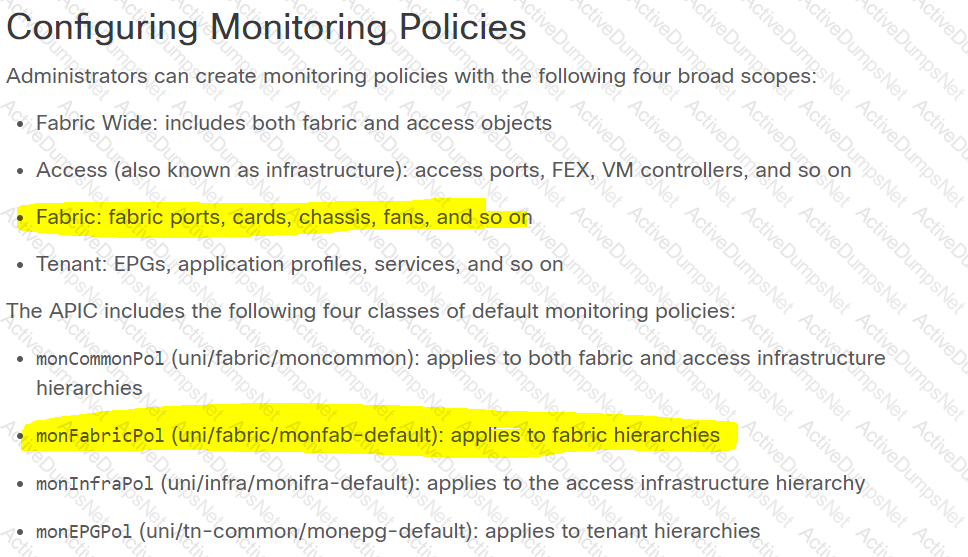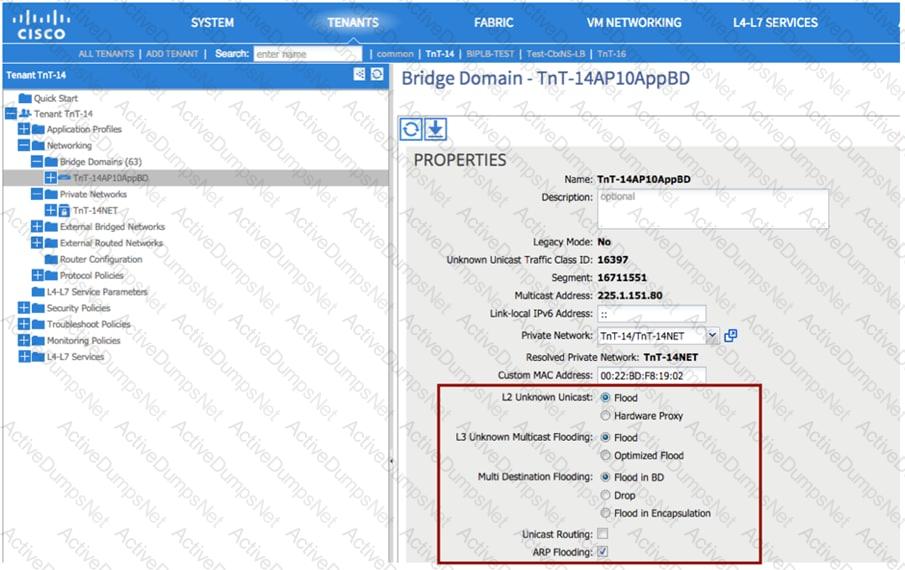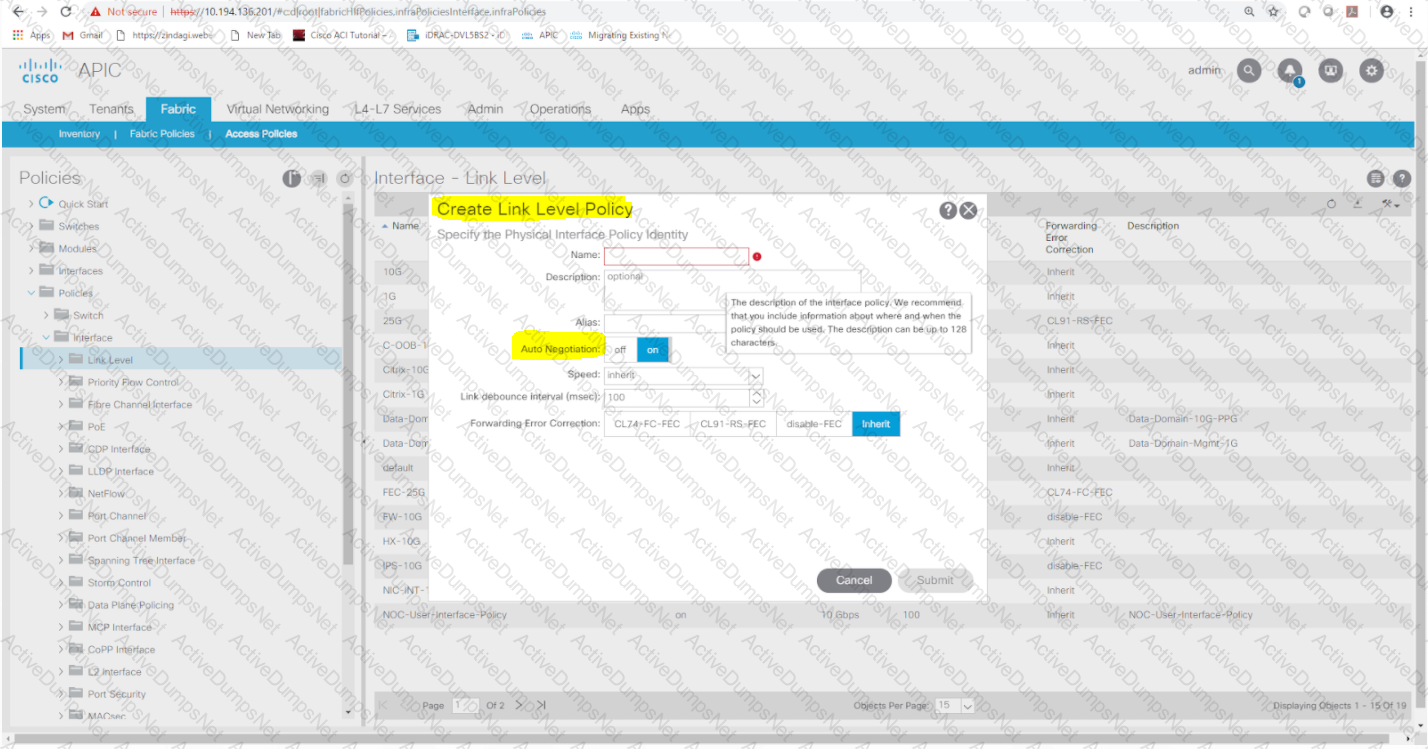Cisco 300-620 Implementing Cisco Application Centric Infrastructure (300-620 DCACI) Exam Practice Test
Implementing Cisco Application Centric Infrastructure (300-620 DCACI) Questions and Answers
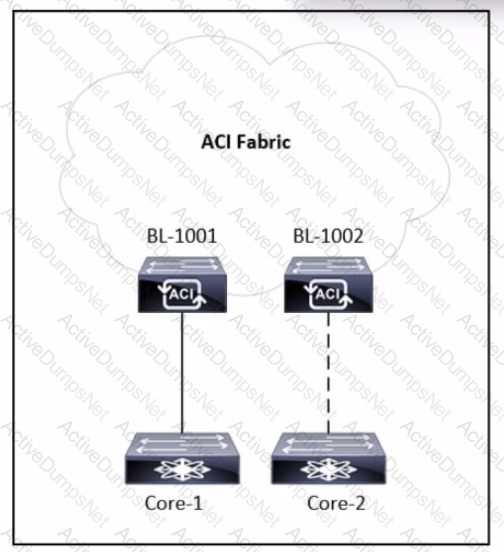
Refer to the exhibit. A tenant is configured with a single L30ut and a single-homed link to the core router called Core-1. An engineer must add a second link to the L30ut that connects to Core-2 router. Which action allows the traffic from Core-2 to BL-1002 to have the same connectivity as the traffic from Core-1 to BL-1001?
An engineer configures a one-armed policy-based redirect service Insertion for an unmanaged firewall. The engineer configures these Cisco ACI objects:
a contract named All_Traffic_Allowed
a Layer 4 to Layer 7 device named FW-Device
a policy-based redirect policy named FW-1Arm-Policy-Based RedirectPolicy
Which configuration set redirects the traffic to the firewall?
As part of a migration, legacy non-ACI switches must be connected to the Cisco ACI fabric. All non-ACI switches run per-VLAN RSTP. After the non-ACI switches are connected to Cisco ACI, the STP convergence caused a microloop and significant CPU spike on all switches. Which configuration on the interfaces of the external switches that face the Cisco ACI fabric resolves the problem?
An engineer configures a Cisco ACI Multi-Pod for disaster recovery. Which action should be taken for the new nodes to be discoverable by the existing Cisco APICs?
An engineer must configure a service graph for the policy-based redirect to redirect traffic to a transparent firewall. The policy must be vendor-agnostic to support any firewall appliance, Which two actions accomplish these goals? (Choose two.)
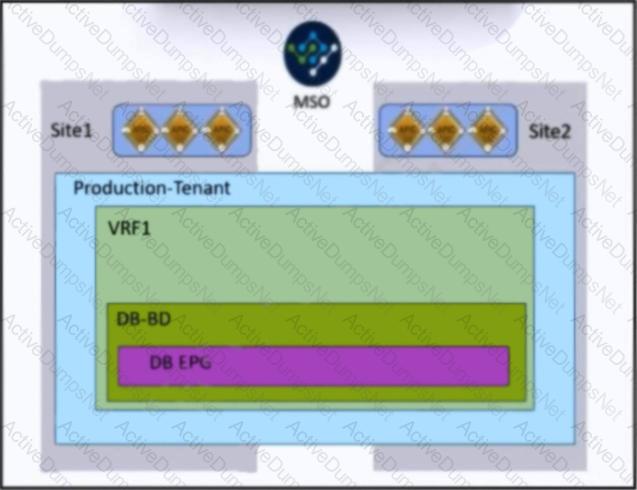
Refer to the exhibit. An engineer must allow IP mobility between Site1 and Site2 in a Cisco ACI Multi-Site orchestrator. The design must meet these requirements:
A disaster recovery (DR) solution must exist between the sites that do not require vMotion support.
The application must be started at a DR site without having to re-IP the application servers.
The solution must avoid any broadcast storms between the sites.
Which two actions meet these criteria? (Choose two.)
Refer to the exhibit.
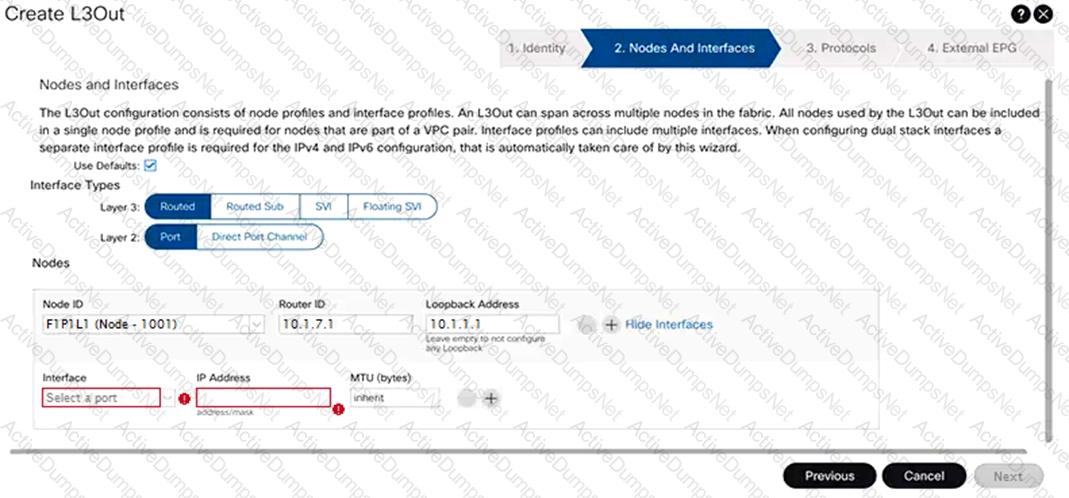
An engineer must configure an L3Out peering with the backbone network. The L3Out must forward unicast and multicast traffic over the link. Which two methods should be used to configure L3Out to meet these requirements? (Choose two.)
Which attribute should be configured for each user to enable RADIUS for external authentication in Cisco ACI?
An engineer must configure VMM domain integration on a Cisco UCS B-Series server that is connected to a Cisco ACI fabric. Drag and drop the products used to create VMM domain from the bottom into the sequence in which they should be implemented at the top. Products are used more than once.

Engineer resolves an underlying condition of a fault but notices that the fault was not deleted from the Faults view. Which two actions must be taken to remove the fault? (Choose two.)
An engineer is implementing Cisco ACI at a large platform-as-a-service provider using APIC controllers, 9396PX leaf switches, and 9336PQ spine switches. The leaf switch ports are configured as IEEE 802.1p ports. Where does the traffic exit from the EPG in IEEE 802.1p mode in this configuration?
What are two descriptions of ACI multi-site? (Choose two.)
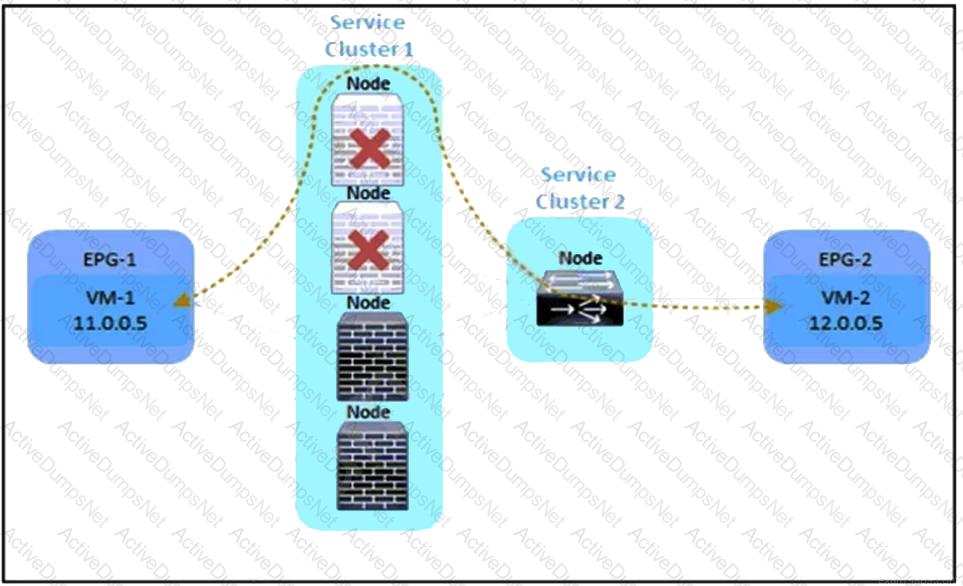
Refer to the exhibit. An engineer must divert the traffic between VM-1 and VM-2 by using a Multi-Node service graph. The solution should prevent an insufficient number of available Layer 4 to Layer 7 devices in the first cluster. Which configuration set accomplishes this goal?
An engineer must securely export Cisco APIC configuration snapshots to a secure, offsite location The exported configuration must be transferred using an encrypted tunnel and encoded with a platform-agnostic data format that provides namespace support Which configuration set must be used?
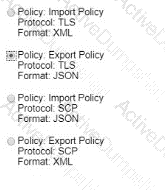
An administrator must migrate the vSphere Management VMkernel of all ESXi hosts in the production cluster from the standard default virtual switch to a VDS that is integrated with APIC in a VMM domain. Which action must be completed in this scenario?
What must be configured to allow SNMP traffic on the APIC controller?
Refer to the exhibit.
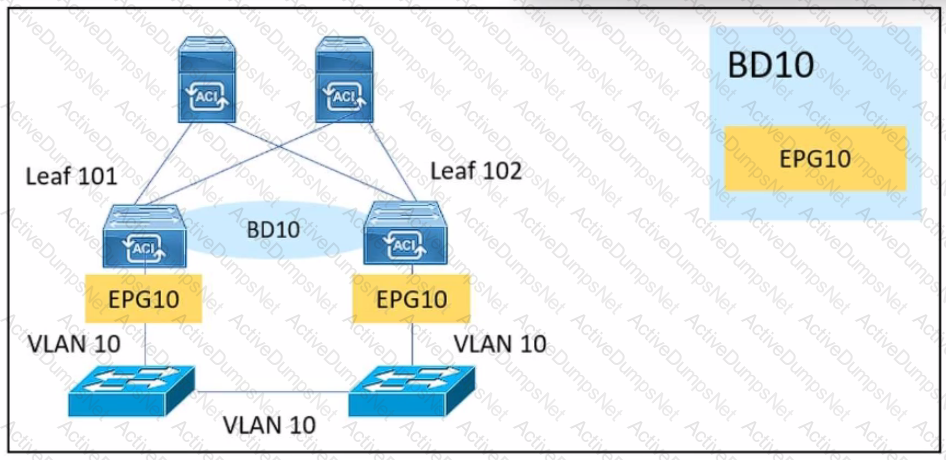
An engineer is implementing a BPDU filter on external switch interfaces That face the Cisco ACI fabric to prevent excessive TCNs from impacting the fabric. Which Configuration must be applied on Cisco ACI to avoid a Layer 2 loop?
A RADIUS user resolves its role via the Cisco AV Pair. What object does the Cisco AV Pair resolve to?
What must be enabled in the bridge domain to have the endpoint table learn the IP addresses of endpoints?
Which two actions extend a Layer 2 domain beyond the ACI fabric? (Choose two.)
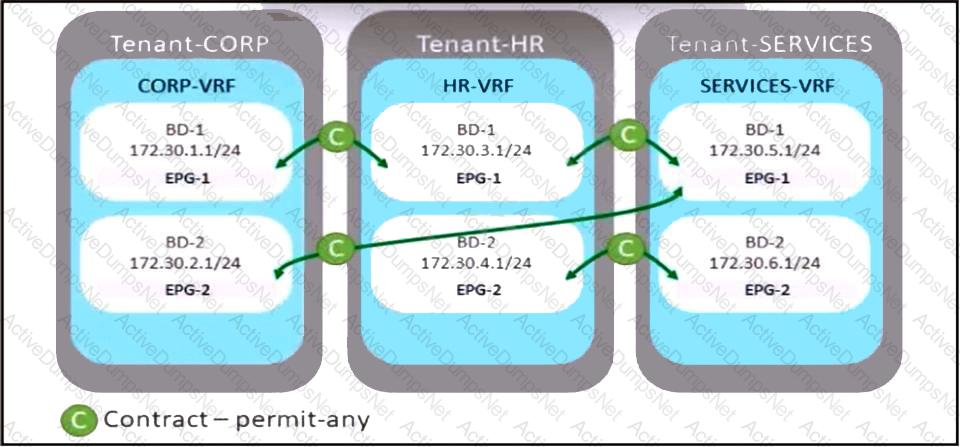
Refer to the exhibit. A company merges three of its departments: CORP, HR, and SERVICES, Currently, the connectivity between departments is achieved by using VRF route leaking. The requirement is to redesign the Cisco ACI networking architecture to communicate between EPGs and BDs from any tenant without configuring contracts or VRF route leaking. Which configuration meets these criteria?
Refer to the exhibit.
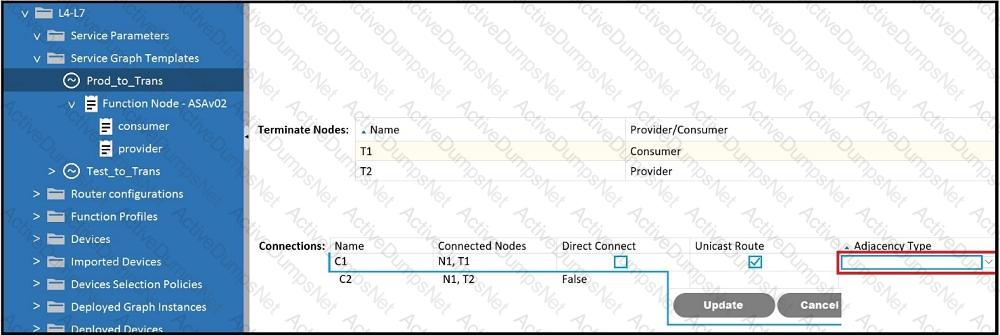
Which Adjacency Type value should be set when the client endpoint and the service node
interface are in a different subnet?
An engineer must deploy Cisco ACI across 10 geographically separated data centers. Which ACI site deployment feature enables the engineer to control which bridge domains contain Layer 2 flooding?
An engineer must set up a Cisco ACI fabric to send Syslog messages related to hardware events, such as chassis line card failures. The messages should be sent to a dedicated Syslog server. Where in the Cisco APIC should the policy be configured to meet this requirement?
When Cisco ACI connects to an outside Layers 2 network, where does the ACI fabric flood the STP BPDU frame?
Refer to the exhibit.
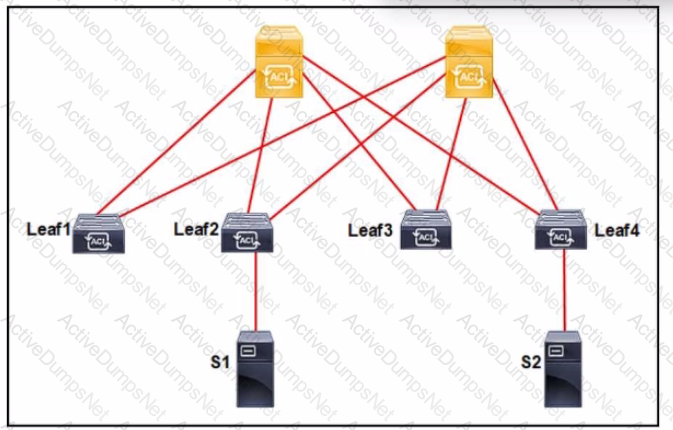
An application called App_1 is hosted on the server called S1. A silent host application. App_2. is hosted on S2. Both applications use the same VLAN encapsulation, which action forces Cisco ACI fabric to learn App_2 on ACI leaf 2?
Which two external entities are referenced by an AEP? (Choose two.)
An engineer configured a bridge domain with the hardware-proxy option for Layer 2 unknown unicast traffic. Which statement is true about this configuration?
What is the name of the automatically configured VLAN 3600 presented during Cisco ACI fabric discovery?
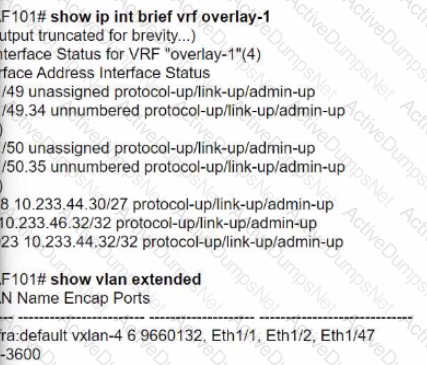
A customer is deploying a new application across two ACI pods that is sensitive to latency and jitter. The application sets the DSCP values of packets to AF31 and CS6, respectively. Which configuration changes must be made on the APIC to support the new application and prevent packets from being delayed or dropped between pods?
The existing network and ACI fabric have been connected to support workload migration. Servers will physically terminate at the Cisco ACI, but their gateway must stay in the existing network. The solution needs to adhere to Cisco’s best practices. The engineer started configuring the relevant Bridge Domain and needs to complete the configuration. Which group of settings are required to meet these requirements?
An engineer configures a Multi-Pod system with the default getaway residing outside of the ACI fabric for a
bridge domain. Which setting should be configured to support this requirement?
Which feature should be disabled on a bridge domain when a default gateway for endpoints is on an external device instead of a Cisco ACI bridge domain SVI?
Refer to the exhibit.
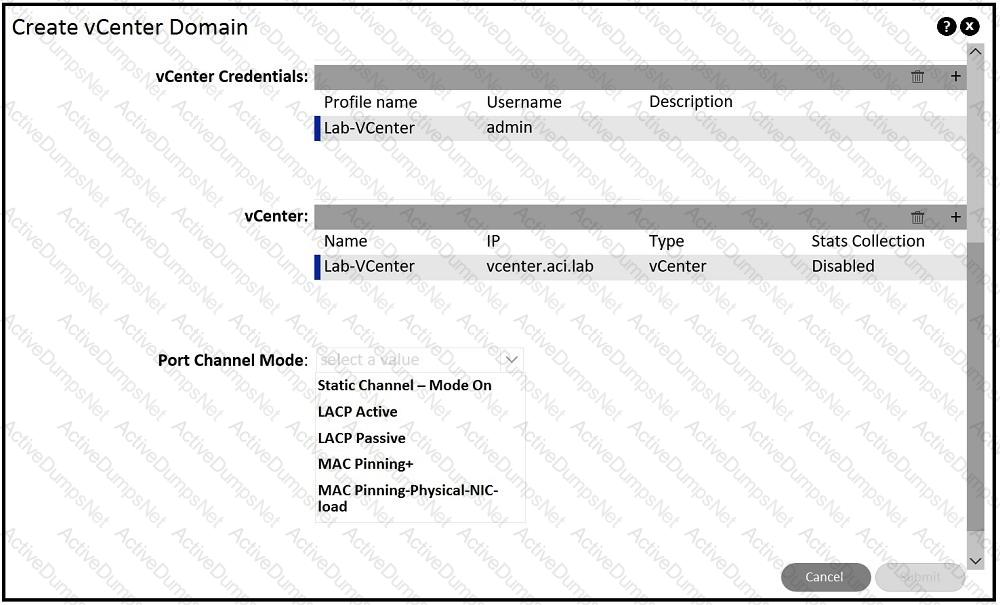
An engineer is implementing Cisco ACI – VMware vCenter integration for a blade server that lacks support of bonding. Which port channel mode results in “route based on originating virtual port” on the VMware VDS?
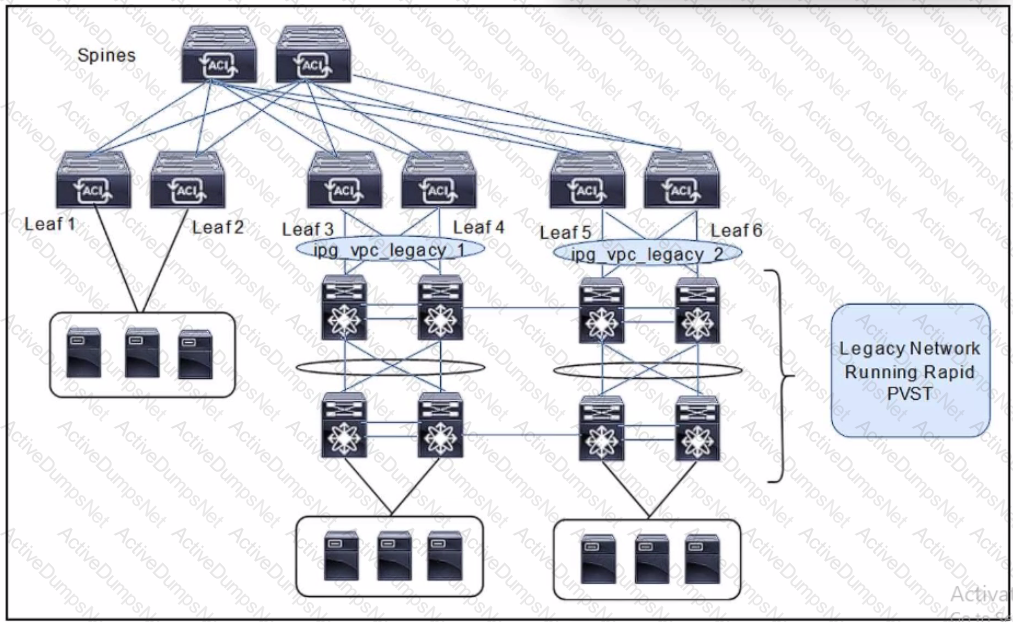
Refer to the exhibit. A client is configuring a new Cisco ACI fabric. All VLANs will be extended during the migration phase using the VPC connections on leaf switches 3. 4 and leaf switches toward the legacy network. The migration phase has these requirements;
* If The legacy switches must be able to transfer BPDUs through the ACI fabric.
* If the legacy switches fail to break a loop. Cisco ACI must break the loop.
Which group settings must be configured on VPC interface policy groups ipg_vpc-legacy_1 and ipg_vpc-legacy_2 to meet these requirements?
On which two interface types should a user configure storm control to protect against broadcast traffic? (Choose two.)
An engineer must configure RADIUS authentication with Cisco ACI for remote authentication with out-of-band management access. Drag and drop the RADIUS configuration steps from the left into the required implementation order on the right. Not all steps are used.
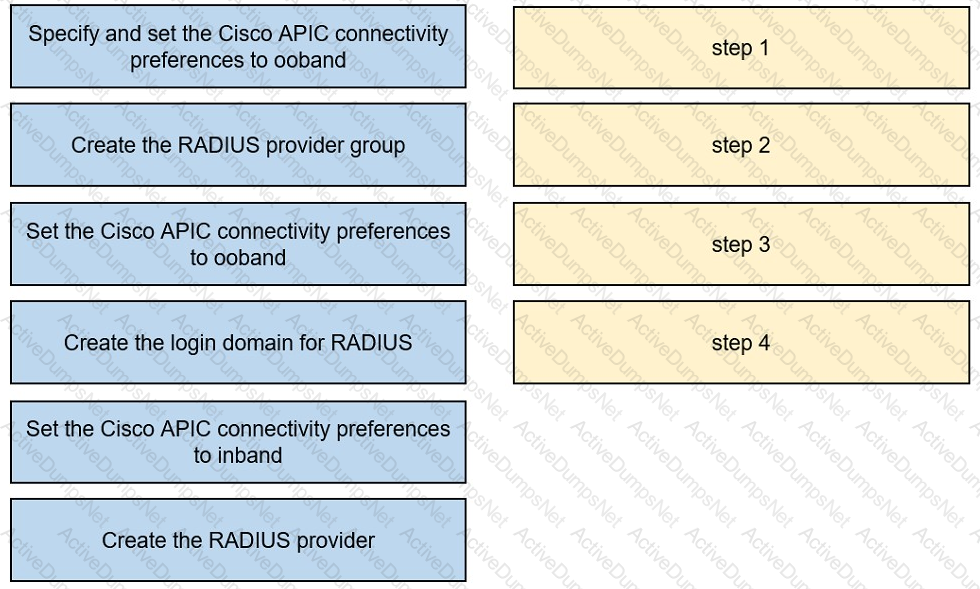
An engineer must configure a Layer 3 connection to the WAN router. The hosts in production VRF must access WAN subnets. The engineer associates EPGs in the production VRF with the external routed domain. Which action completes the task?
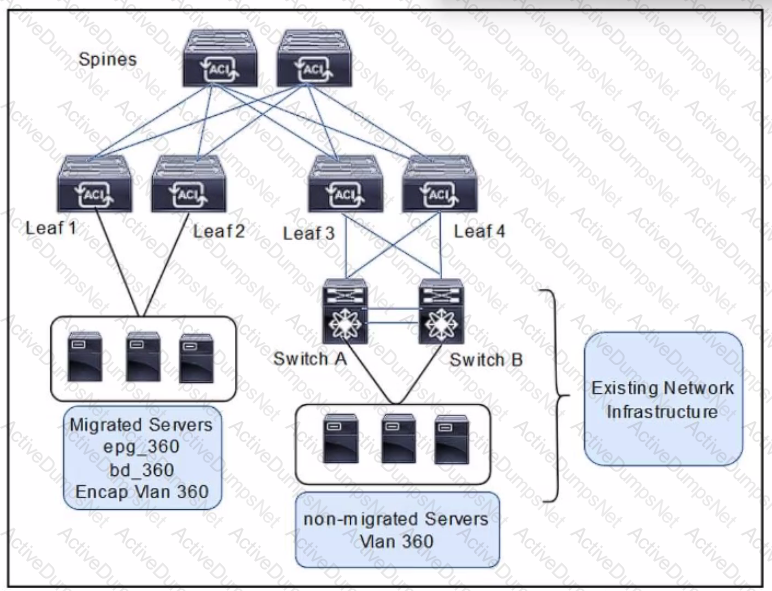
Refer to the exhibit. An engineer is migrating legacy servers into the Cisco ACI environment. The requirement is to ensure that all endpoints and MAC addresses are learned properly in legacy and Cisco ACI switches. Which configuration set must be configured under the bridge domain called bd__360 to accomplish this goal?
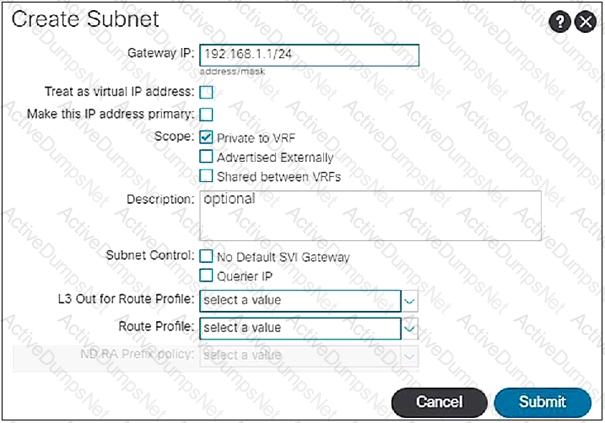
When the subnet is configured on a bridge domain, on which physical devices is the gateway IP address configured?
An engineer is implementing a Cisco ACI environment that consists of more than 20 servers. Two of the servers support only Cisco Discovery Protocol with no order link discovery protocol. The engineer wants the servers to be discovered automatically by the Cisco ACI fabric when connected. Which action must be taken to meet this requirement?
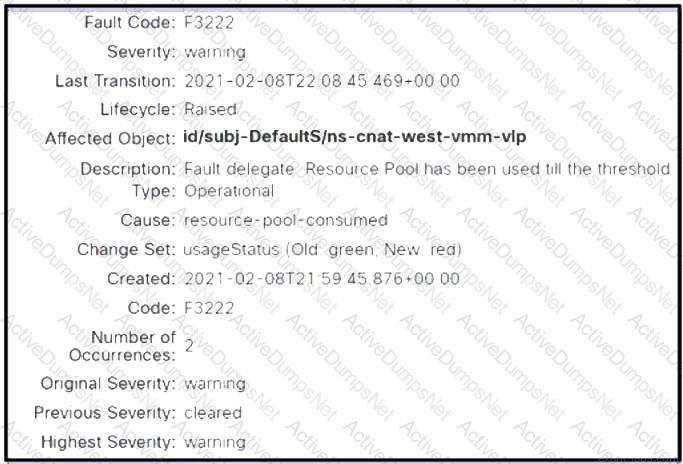
Refer to the exhibit. A Cisco APIC raises an error when the EPG must accept endpoints from a VMM domain created. Which action clears the fault?
In the context of ACI Multi-Site, when is the information of an endpoint (MAC/IP) that belongs to site 1 advertised to site 2 using the EVPN control plane?
What must be configured to redistribute externally learned OSPF routes within the ACI fabric?
What does a bridge domain represent?
How is an EPG extended outside of the ACI fabric?
Refer to the exhibit. VM1 and VM2 are in Cisco ACI POD1 and communication takes place. Which event is triggered when VM2 is live migrated from POD1 to POD2?
Which two statements regarding ACI Multi-Site are true? (Choose two.)
What are two PBR characteristics of the Cisco ACI Active-Active Across Pods deployment mode in Cisco ACI Multi-Pod design? (Choose two.)
Which feature dynamically assigns or modifies the EPG association of virtual machines based on their attributes?
A bridge domain for an EPC called “Web Servers” must be created in the Cisco APIC. The configuration must meet these requirements:
Only traffic to known Mac addresses must be allowed to reduce noice.
The multicast traffic must be limited to the ports that are participating in multicast routing.
The endpoints within the bridge domain must be kept in the endpoint table for 20 minultes without any updates.
Which set of steps configures the bridge domain that satisfies the requirements?
Engineer must configure SNMP inside a Cisco ACI fabric. The engineer has created an SNMP Policy, called SNMP-policy and an SNMP Monitoring Group called SNMP-group1 that Contains five trap receivers. Which configuration set completes the configuration?
Network engineer configured a Cisco ACI fabric as follows:
• An EPG called EPG-A is created and associated with a VMM domain called North. •The EPG-A is associated with BD-A and is in an application profile called Apps-A.
• The BD-A is associated with VRF-1 in the Prod tenant.
Which port group must be selected to place VMs in EPG-A?
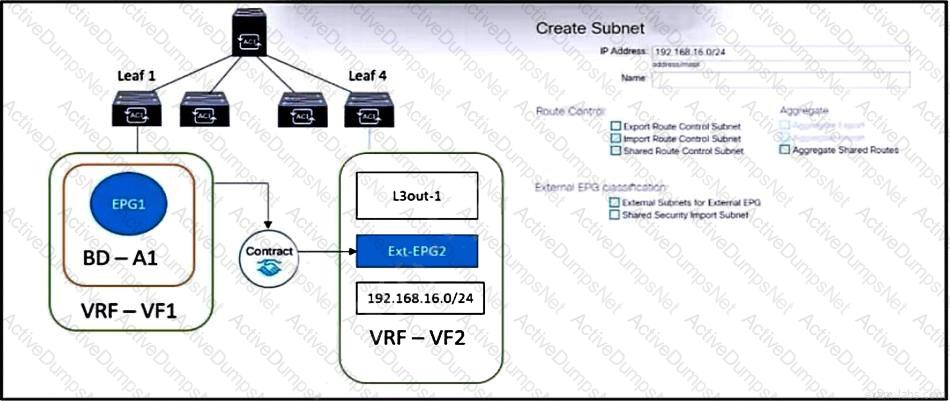
Refer to the exhibit. The external subnet and internal EPG1 must communicate with each other, and the L3Out traffic must leak into the VRF named "VF1". Which configuration set accomplishes these goals?
An engineer needs to deploy a leaf access port policy group in ACI Fabric to support the following requirements:
• Control the amount of application data flowing into the system
• Allow the newly connected device to auto-negotiate link speed with the leaf switch
Which two ACI policies must be configured to achieve these requirements? (Choose two.)
Which protocol does ACI use to securely sane the configuration in a remote location?
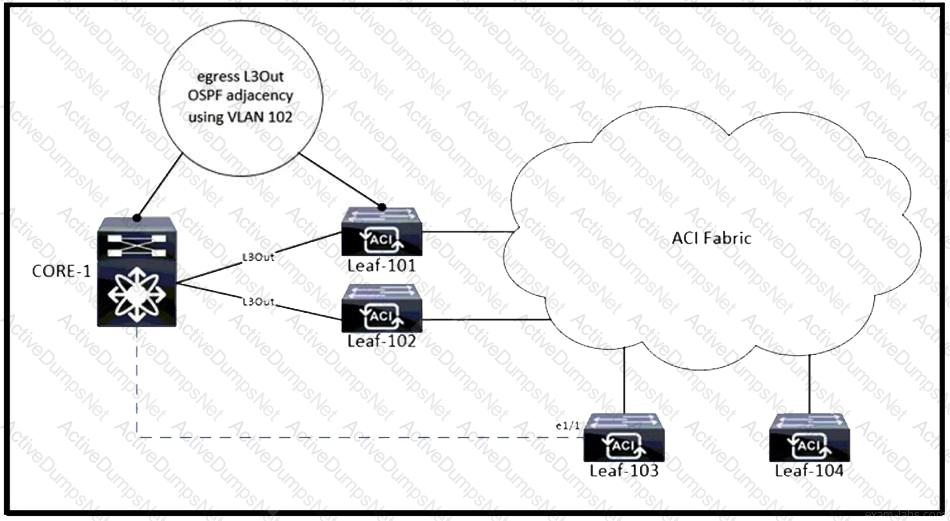
Refer to the exhibit. The Cisco ACI fabric has an egress L3Out from Leaf-101 and Leaf-102 to CORE-1. VLAN 102 is used to form the OSPF adjacency. The workloads must be migrated into EPG-101, and the static port binding is configured to Leaf-103 e1/1 with encap VLAN 101. An engineer completes the port binding and receives an MCP fault. Which action clears the fault?
An engineer configures an L30ut in VRF-1 that was configured for Import Route Control Enforcement. The L30ut uses OSPF to peer with a core switch. The L30ut has one external EPG, it has been configured with a subnet 10.1.0.0/24. Which scope must be set to force 10.1.0.0/24 to populate in the routing table for VRF-1?
A Cisco ACI bridge domain and VRF are configured with a default data-plane learning configuration. Which two endpoint attributes are programmed in the leaf switch when receiving traffic? (Choose two.)
Regarding the MTU value of MP-BGP EVPN control plane packets in Cisco ACI, which statement about communication between spine nodes in different sites is true?
A network engineer must allow secure access to the Cisco ACl out-of-band (OOB) management only from external subnets 10 0 0024 and 192.168 20 G'25. Which configuration set accomplishes this goal?
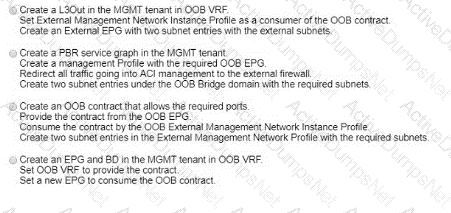
An ACI engineer is implementing a Layer 3 out inside the Cisco ACI fabric that must meet these requirements:
The data center core switch must be connected to one of the leaf switches with a single 1G link.
The routes must be exchanged using a link-state routing protocol that supports hierarchical network design.
The data center core switch interface must be using 802.1Q tagging, and each vlan will be configured with a dedicated IP address.
Which set of steps accomplishes these goals?
A Solutions Architect is asked to design two data centers based on Cisco ACI technology that can extend L2/ L3, VXLAN, and network policy across locations. ACI Multi-Pod has been selected. Which two requirements must be considered in this design? (Choose two.)
All workloads in VLAN 1001 have been migrated into EPG-1001. The requirement is to move the gateway address for VLAN 1001 from the core outside the Cisco ACI fabric into the Cisco ACI fabric. The endpoints in EPG-1001 must route traffic to endpoints in other EPGs and minimize flooded traffic in the fabric. Which configuration set is needed on the bridge domain to meet these requirements?
Which setting prevents the learning of Endpoint IP addresses whose subnet does not match the bridge domain subnet?
An ACI administrator notices a change in the behavior of the fabric. Which action must be taken to determine if a human intervention introduced the change?
An engineer is configuring ACI VMM domain integration with Cisco UCS-B Series. Which type of port channel policy must be configured in the vSwitch policy?
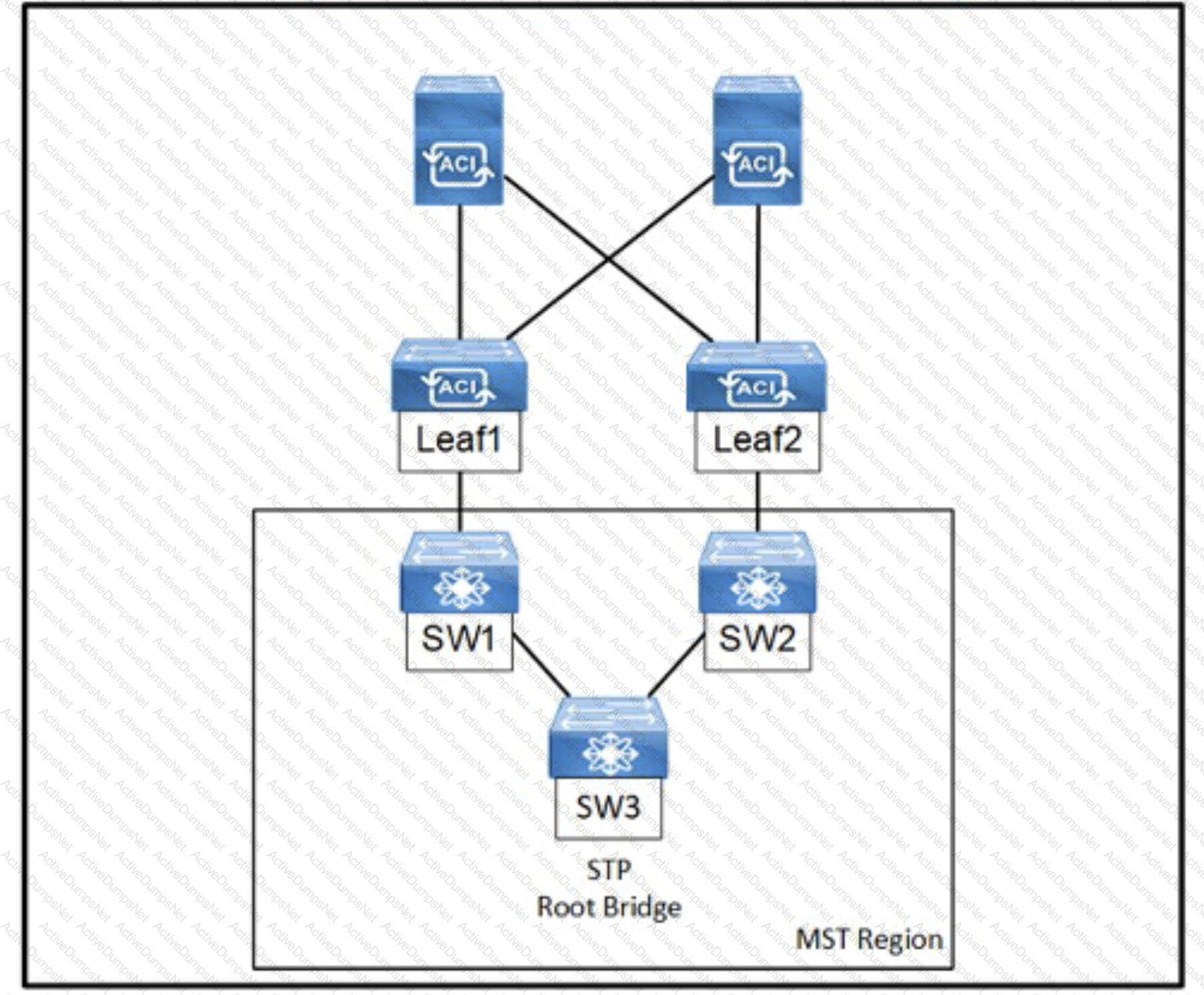
Refer to the exhibit, An engineer is deploying a Cisco ACI environment but experiences a STP loop between switch1 and switch2. Which configuration step is needed to break the STP loop?
What is the purpose of the Overlay Multicast TEP in a Cisco ACI Multi-Site deployment?
An engineer wants to monitor all configuration changes, threshold crossing, and link-state transitions in a Cisco ACI fabric. Which action must be taken to receive the required messages?
What is the result of selecting the On Demand attribute in the Deploy Immediacy feature during VMM domain association to an EPG?
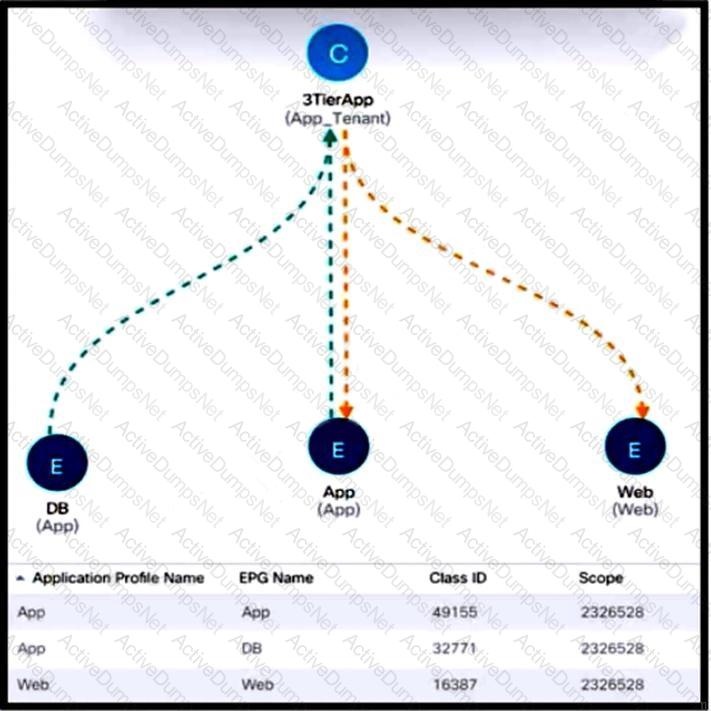
Refer to the exhibit. New e-commerce software is deployed on Cisco ACI fabric. The environment must meet these requirements:
The overall number of contracts must be reduced by reusing the existing contracts within a VRF when possible.
The e-commerce software must communicate only with software EPGs that are part of the same ANP.
The e-commerce software must be prevented from communicating with applications in different ANPs.
Which scope must be selected to meet these requirements?
Which two dynamic routing protocols are supported when using Cisco ACI to connect to an external Layer 3 network? (Choose two.)
Which description regarding the initial APIC cluster discovery process is true?



